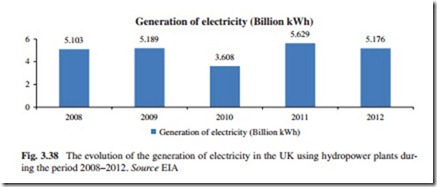United Kingdom
The great period of hydropower construction occurred in the years after the Second World War—from 1948 to 1965, when most of the Scottish schemes were built by the North of Scotland Hydroelectric Board. Since that time, there has been little further construction due to increasing opposition to reservoir construction on environmental grounds.
Hydropower Installed Capacity
Today, there are over 50 main hydropower plants in Scotland with an installed capacity of around 1,050 MW. In addition, there are three pumped-storage hydro- power plants with a combined capacity of 830 MW. In Wales, the Dinorwig pumped-storage scheme has an installed capacity of 1,200 MW and there are two other main hydropower plants providing 16 MW.
The installed hydroelectric capacity in the UK in 2012 was 1,658 MW, which represent 1.57 % of the total capacity installed in the country in that year and 1.43 % of the total renewables capacity installed. This includes for conventional hydroelectric power plants and run-of-river schemes for which annual electricity production is approximately 5,000 GWh, being about 1.3 % of the UK’s total electricity production. In addition, there are also pumped-storage hydropower plants providing a further 2.8 GW of installed electrical generating capacity and contrib- uting up to 4,075 GWh of peak demand electricity annually.
At world level, the UK occupies the place 62 (0.17 % of the world total) according to the hydropower installed capacity and the place 19 within the European region (0.98 % of the total regional capacity installed). During the past ten years in nine of them, the participation of hydropower in the generation of electricity in the UK increased 1.10 % as average.
This includes for conventional hydroelectric power plants and run-of-river schemes for which annual electricity production is approximately 5,000 GWh, being about 1.3 % of the UK’s total electricity production (Department of Energy and Climate Change 2012). In addition, there are also pumped-storage hydroelectric power plants providing a further 2.8 GW of installed electrical generating capacity and contributing up to 4,075 GWh of peak demand electricity annually (UK Department of Energy and Climate Change 2013).
The potential for further practical and viable hydropower plants in the UK is estimated to be between 146 and 248 MW for England and Wales (British Hydro Association Report 2010) and up to 2,593 MW for Scotland (British Hydro Association Report 2008). However, by the very nature of the remote and rugged geographic locations of some of these potential sites, in national parks or other areas of outstanding natural beauty, it is likely that environmental concerns would mean that a large number of them would be deemed not to be suitable, or could not be developed to their full theoretical potential.
Interest in hydropower in the UK has been renewed in recent years due to new UK and EU targets for reductions in carbon emissions and the promotion of renewable energy power generation through commercial incentives such as the Renewable Obligation Certificate Scheme (ROCs) and FiTs. Prior to such schemes, previous studies to assess the available hydro resources in the UK had discounted a large number of sites for reasons of poor economic or techno- logical viability, but more recent studies in 2008 and 2010 by the British Hydro Association have identified a larger number of viable sites due to improvements in the available technology and the economics of ROCs and FiTs.
The UK government’s NREAP of July 2010 envisages between 40 and 50 MW of new hydropower schemes being installed annually up to 2020. The most recent feedback for new hydro schemes is for 2009, and approximately 15 MWe of new hydropower was installed during that year. It therefore remains to be seen if the ROC and FiT incentives will be enough for these ambitious targets to be met.
Hydropower Electricity Generation
The evolution of the generation of electricity in the UK using hydropower plants during the period 2008–2012 is shown in Fig. 3.38.
According to Fig. 3.38, the generation of electricity using hydropower plants in the UK during the period 2008–2012 increased 1.4 %. Total hydroelectric capacity in the UK remained approximately the same over the last ten years, but because
of the gradual increase in total generating capacity, currently about 60,000 MW, its share is gradually decreasing. There is, however, a definite increase in the use of small hydropower plants, but this is too small to compensate for the declining market share. It is expected that the participation of hydropower in the generation of electricity in the UK will continue to decrease at least during the coming years.
